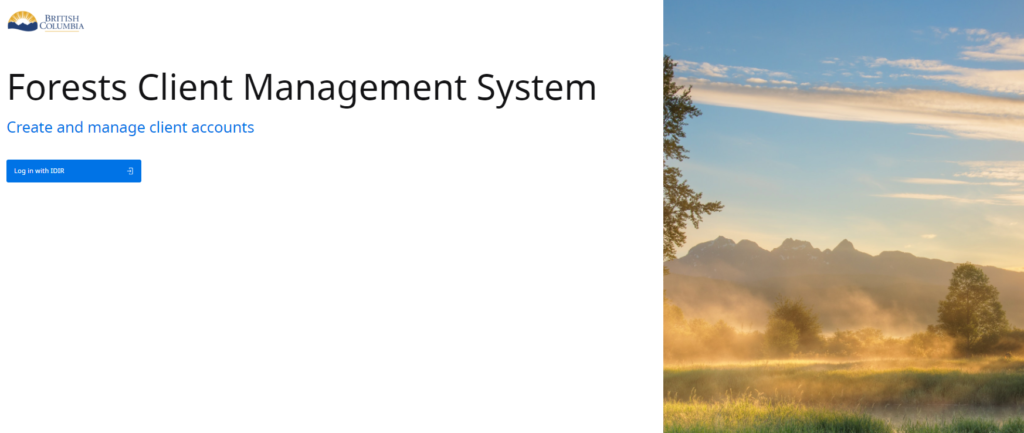Transforming the Forests Client Management System
|

Forestry in B.C. is changing and the Ministry of Forests is meeting the challenge. One example is the work of Forestry Digital Services (FDS), who are transforming forestry applications like the Forests Client Management System (Forests Client).
Forests Client assigns a client number to every business or individual the Ministry of Forests deals with, which is used for invoicing clients, awarding contracts and tenures, making payments and sending correspondence. The client number is also used to access services from other ministry applications.
But Forests Client is a legacy system with design drawbacks that have slowed its performance over time. When FDS determined Forests Client could no longer meet the needs of the public, staff and programs that rely on it, updating the system became a priority to help support the ministry and protect the $6 billion it contributes to B.C.’s economy.
The starting point
Before the update, the system had several challenges for users and staff.
Inefficient manual processes
Originally, getting a client number was a manual process. Clients had to download and print a paper form from the web and submit it to a government office. Staff would then have to search Forests Client to ensure the applicant didn’t already have a client number, transcribe the form’s data, check the applicant’s ID and generate a number. This was time-consuming and could result in errors.
User interface design and (in)accessibility
The legacy client also didn’t follow best practices for user interface design. For instance, it didn’t include some important required fields like telephone numbers and email addresses. This made the system’s data incomplete which proved a challenge for users who need these data to contact clients.
The legacy client was also inaccessible to people with disabilities. But the new design is navigable with a keyboard and works with screen readers and magnifiers.
Poor data quality
Data quality was another area flagged for improvement. Using technology to boost the quality of data going into the system would reduce the time administrators spend fixing errors and addressing omissions.
The approach
FDS comprises four teams working to transform the Forests Suite of Applications (FSA), a group of 40+ applications used in the forestry sector. Each FDS team works on one or two applications at a time, with FDS Team Alliance tackling Forests Client. All FDS teams use service design and Agile in their work.
A service design focus
Team Alliance uses service design, a human-centred and collaborative approach to creating products and services, in their work on Forests Client.
Application development is sometimes based on assumptions about what the application’s users will need. Service designers aim to resist this tendency by working closely and continuously with the users to understand what they need it to do.
Service design is complex and non-linear, but often begins with desk research and results in a working prototype. Between these two points, service designers conduct interviews, consultations, journey mappings and design tests with users. The resulting prototype guides developers in their creation of the final product.
This process doesn’t only address how a product looks, feels and operates at the front end. It also helps developers understand what functionalities to build at the application’s back end.
Agile
Team Alliance is also taking an Agile approach to the development of Forests Client. Agile organizes a project’s design, development and testing tasks into set periods called “sprints,” during which the team works on predetermined tasks. They enable teams to organize their own work and to adapt to changing needs. It also means Forests Client is being modernized and launched in stages. Users will have to toggle between the old and new systems until the modernized Forest Client is done.
New and improved
The revised Forests Client submission form went live to the web on April 24, 2024. It updates the manual client number application process by moving it online. The goal was to have 80% of new client number applications being submitted online. While this target has yet to be met, online applications have increased since the launch. Applicants have shared positive feedback, with one noting that using the online form to get a number was the easiest transaction they’ve ever had with government.

Identity authentication made easier
Instead of printing, completing and submitting a paper form to a government office, applicants can now go online and apply for a number anywhere. To apply, businesses (and other legal entities such as non-profits) in good standing with BC Registries, must have a BusinessBCeID and an email address, while individuals must have a BC Services Card Login account and an email address.
A user-first experience
The submission form itself follows best practices in user design. For example, it makes completing the form easy using progressive disclosure, simplifying the interface and reducing complex operations into manageable parts. This lessens the cognitive load on the applicant and makes completing the form less daunting.
The submission form also uses field validation, mandatory fields and auto-populate, ensuring required data are complete and correct. (On seeing auto-populate in action, one staff tester exclaimed, “Auto populate. Less mistakes? OK, love it!”) The form also includes error messages applicants can understand, making errors easy to resolve, improving the user experience and resulting in better data.
Better connectivity
The form also employs application programming interfaces (APIs) to retrieve data. One checks business applicants are in good standing with BC Registries. If they’re not, the form refers them to the registries to find out why. This will save staff time as they won’t need to check the registry themselves. When shown this function in a demonstration, one staff user said, “Like to me this is easy peasy and when they put in their business name it pulls it up from BC Registries Online correct?”
The other is a Canada Post API that ensures the address entered by the applicant is complete and correct. This API will improve the accuracy of data in the system, making it more useful to the ministries and programs that rely on it.
These APIs will also make it possible for the system to automatically assign new client numbers to applicants if their application meets certain conditions. This will save staff time and make getting a client number easier and faster.
An intuitive dashboard
The updated Forests Client system includes a dashboard interface to make it easy for staff to review and approve online client number applications. The dashboard follows best practices in design and was co-designed and evaluated with users.
Staff screens
Applicants for a client number can still apply in-person at a resource district office, Front CounterBC or ServiceBC centre, and the team has also improved this process.
As of Fall 2024, the system includes staff screens to make it easier to serve applicants in-person. These screens share the functionality of the online form and dashboard and include other new features like a notes function.
More to come
FDS Team Alliance is still researching and developing other Forests Client functions. These include the ability for staff to update client data and create joint ventures and better search results.
The continuing improvement of the Forests Client Management System has been a success. It’s now easier and faster for the public to apply for a client number. And it will soon be easier to serve applicants, manage client number applications made at government offices and update system data.
Transforming the system has also demonstrated the value of service design and Agile when improving applications. Both approaches value the satisfaction of users over anything else, allowing designers and developers to pivot as research and testing uncover new needs. These are attributes appreciated by Team Alliance – and all Forestry Digital Services teams – as they carry this work into the future.
If you have questions about Forests Client Management System modernization, please email the FDS Program.
To learn more about the FDS program, visit the FDS website or watch the FDS introductory video.
